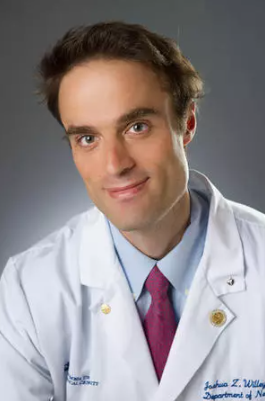What to Know About the Rising Stroke Rates in Younger People
A stroke neurologist explains the reasons that stroke prevalence has increased, including among people younger than 64, and offers tips on how to reduce stroke risk.

While many people may consider a stroke to be a medical emergency that affects older people, the rates of stroke among younger adults are on the rise. According to a report from the Centers for Disease Control and Prevention (CDC), which compared two time spans, 2011-13 and 2020-22, that overall stroke prevalence rose by 8%, with a more significant increase for people ages 18 to 44 (14.6%) and ages 45 to 64 (15.7%).
“An increase in obesity and other health conditions like diabetes among younger people is translating into earlier cardiovascular disease and rising the risk of stroke earlier on in life,” says Dr. Joshua Willey, a stroke neurologist at NewYork-Presbyterian/Columbia University Irving Medical Center.
Those who were 65 and older were most likely to have a stroke (7.7%), but incidence of stroke in this older age group have not increased over the years.
“While stroke remains less common among the younger population, the steep increase in rates is a concern,” says Dr. Willey.
Health Matters spoke with Dr. Willey to better understand why stroke is increasing in younger people, health conditions that are contributing to the rise, and how to spot signs and symptoms of strokes.

Dr. Joshua Willey
What health problems are contributing to the increase in stroke among younger people?
Dr. Willey: The main ones elaborated on in the CDC report and ones we have seen from other studies are a rise in obesity, physical inactivity, diabetes, and high blood pressure in younger people. This is translating to earlier cardiovascular disease and stroke, as the report outlines. In terms of high blood pressure, for example, it has been estimated that if it is treated, it would help prevent 50% of strokes in the U.S.
Other than cardiovascular conditions and obesity, the opioid overdose epidemic may also be contributing to the rise in young people. There has been an increase in intravenous (IV) opioid use, and IV drug use is linked to infections in heart valves that can cause strokes.
Are the signs of stroke in younger people similar to those in older people?
The symptoms of stroke in both younger and older patients tend to be similar, though young patients’ outcomes tend to be better because at baseline, they have a better physical status, such as fitness and mobility. Since stroke tends to be less common in those who are younger, symptoms could be mistaken for a migraine, pinched nerves, or multiple sclerosis.
What are the different kinds of strokes?
There are two major types of strokes. One of them is ischemic, which is like a blocked pipe. When this occurs, blood is not getting to a certain part of the brain and that part of the brain dies. There is also a hemorrhagic stroke, which is when the arteries burst.
In the U.S., ischemic stroke is about 80% of all strokes, though there is significant differences by communities. Communities that have higher rates of high blood pressure and social determinants of health are more likely to present with hemorrhagic stroke. This kind of stroke has a higher chance of being fatal compared to an ischemic stroke. Patients with this type of stroke present uniformly with a severe onset, rapid headache, often an impairment of consciousness, which you do not necessarily see with other types of stroke.
Younger patients tend to have different types of stroke but for the most part, the rates of hemorrhagic strokes and ischemic strokes remain the same. One notable exception is pregnancy-related strokes, where hemorrhagic ones can be more likely.
If someone is having a stroke, what can people keep in mind in terms of improving outcomes?
Most people can identify signs and symptoms of a heart attack, but not for stroke, so it is important to be familiar with them. The acronym BE FAST covers most stroke symptoms. In 2021, the AHA endorsed a version of BE FAST in Spanish: RÁPIDO. It is important to emphasize that if someone has these symptoms, and they only lasted a few minutes, it could be a sign that a bigger stroke is about to come. People should still come to the hospital as quickly as possible.
BE FAST stands for:
B: Sudden loss of balance or unsteady walking.
E: Double vision or loss of vision.
F: The face becomes droopy on one side compared to the other.
A: Arm drops when trying to lift it, or the patient is unable to move the arm.
S: Speech becomes slurred and speaking is unintelligible or gibberish.
T: Time to call 911. People are seen and treated more quickly when they arrive by ambulance. Ambulances can notify the hospital ahead of time that they are coming in with a stroke patient. For every minute lost, it is almost 2 billion neurons that you lose, or 2 billion brain cells.
What are ways to reduce risk of stroke?
The American Heart Association (AHA) has measures called Life’s Essential 8, which goes a long way to reducing the chances of not just heart disease and other health problems, but also stroke. The measures are eating better, being more active, quitting tobacco, getting healthy sleep, managing weight, controlling cholesterol, managing blood sugar, and managing blood pressure.
Eating better could include having a diet rich in vegetables, such as the Mediterranean diet. Aim for a diet with less fried foods and lower on the glycemic index if you have diabetes. In terms of getting active, daily exercise for at least 30 minutes daily would be ideal. Managing weight is key so that your body mass index – the ratio of your weight to your height – is anywhere between 18 to 25. Monitoring blood pressure, blood sugar, and cholesterol is also important to manage if they are high.
How can people with cardiovascular conditions manage them to prevent stroke?
We are going to potentially see an increase and more emphasis on managing blood pressure. We used to say a blood pressure of 140 was OK, but now we are pushing the agenda more on having blood pressure be less than 120. This is one way that could help reduce risk of stroke. We have also seen significant changes in the management of diabetes. New onset diabetes drugs and self-monitors on the skin have been a positive development and are helping people better manage the condition.
It is important to continue to get people to the doctor and there are going to be economic forces, including access to healthcare, that limit that. Stroke overall is a major source of healthcare-related disparities. Having culturally tailored programs and meeting people where they are is important for stroke prevention. This can help inform what the stroke signs and symptoms are, increase screening, and improve management of different health conditions, like high blood pressure.
Joshua Willey, MD, is an attending neurologist on the stroke service at NewYork-Presbyterian/Columbia University Irving Medical Center and an associate professor of neurology at Columbia University Vagelos College of Physicians and Surgeons. Dr. Willey has an outpatient clinical practice in neurology with a focus on cerebrovascular diseases and stroke and he treats inpatient stroke patients.
Additional Resources
Learn more about stroke services at NewYork-Presbyterian.
